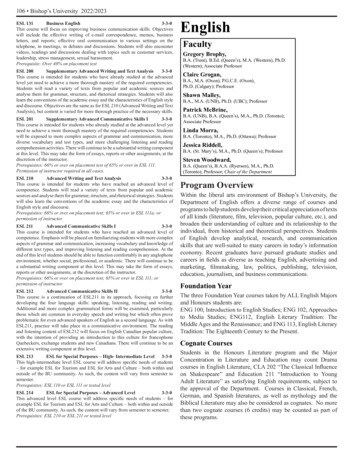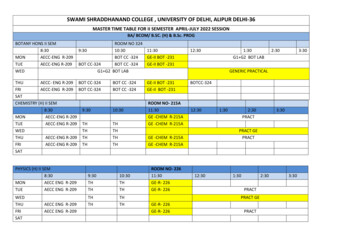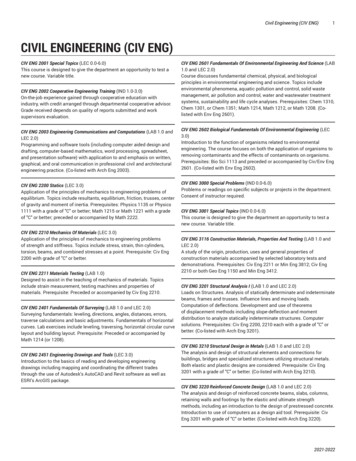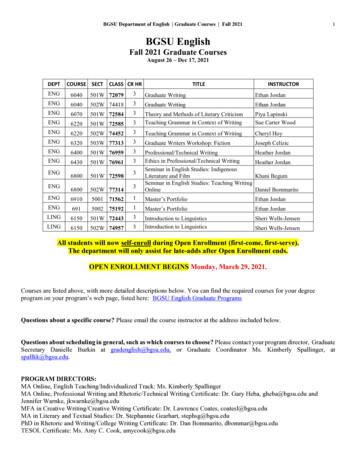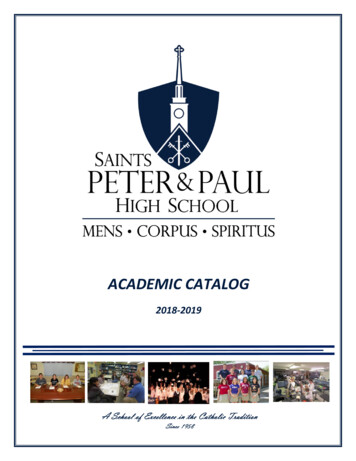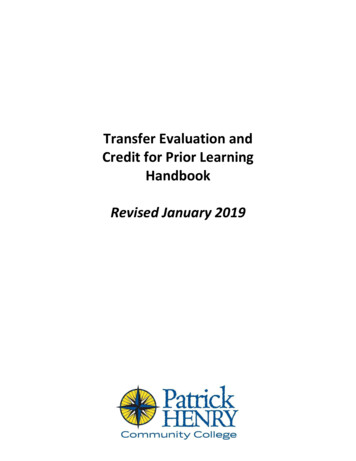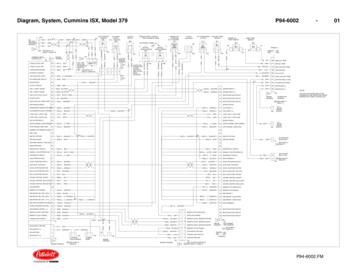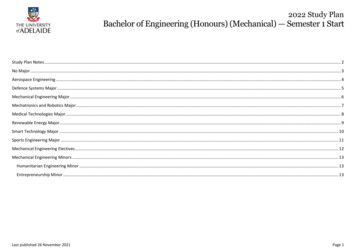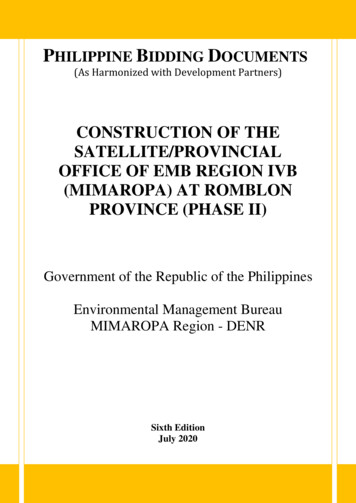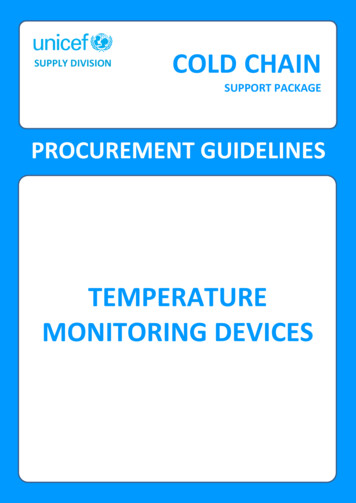
Transcription
WHO IVB 15.04 eng.pdfSUPPLY DIVISIONCOLD CHAINSUPPORT PACKAGEPROCUREMENT GUIDELINESTEMPERATUREMONITORING DEVICES
Procurement GuidelinesTemperature Monitoring DevicesKey information for UNICEF staff and partners, ensuring effective andefficient procurement of Cold Chain equipment.This module gives guidance to the procurement of temperaturemonitoring devices for vaccine storage and distribution.Always make sure that you have the latest versionof this document by checking the CCSP website.Document Update: October 06, 2016Suggestions and feedback: sd.coldchain@unicef.org
Contents1INTRODUCTION TO TEMPERATURE MONITORING . 12CLASSIFICATION OF TEMPERATURE MONITORING DEVICES . 22.1CATEGORIES OF APPLICATION . 22.2DEVICES FOR COLD ROOMS AND FREEZER ROOMS . 32.2.1 Central Temperature Monitoring System . 3Central TMS, Example 1: Smart View .4Central TMS, Example 2: Beyond Wireless .42.2.2 Multilog with 8, 12,16, and 24 Sensors (Non PQS) . 42.2.3 Pen Chart Recorder with Charts for 7 Days (Non PQS). 42.3DEVICES FOR REFRIGERATORS AND FREEZERS . 52.3.1 User Programmable Temperature Data Logger . 52.3.2 30 Day Electronic Temperature Logger . 52.3.3 Dial Thermometer . 62.4DEVICES FOR TRANSPORTATION IN COLD BOXES AND VACCINE CARRIERS . 62.4.1 Electronic Freeze Indicator . 62.4.2 Cold Chain Monitor . 62.4.3 Vaccine Vial Monitor (VVM) . 72.4.4 Electronic Shipping Indicator . 73DEVICES SUPPLIED BY UNICEF SD . 84DEVICES IN THE WHO PQS . 85HOW TO ORDER . 95.1THE ORDERING PROCESS . 95.2CONSIDERATIONS FOR COUNTRY OFFICES . 95.3DELIVERY LEAD TIME . 9ANNEX 1: ADDITIONAL RESOURCES . 9ANNEX 2: RECORD OF REVISIONS . 11
d Chain Support PackageCountry OfficeDirect Order ArrangementLong Term ArrangementPrimary Health CarePerformance Quality and SafetyPrequalification TeamProcurement ServicesSupply Division (UNICEF)Vaccine CarrierVaccine Vial MonitorWorld Health OrganizationWalk-In Cold RoomWalk-In Freezer Room
Procurement Manual: Temperature Monitoring Devices1 Introduction to Temperature MonitoringVaccines are biological products that can lose their potency if exposed to excessive heat and/or freezing.Different vaccines have different sensitivity to freezing and heat; it is because of this phenomenon thatmonitoring the temperature of vaccines during storage and transportation is vital.Temperature monitoring devices are needed to keep track of the temperature to which the vaccines anddiluents are exposed. Based on the data from these devices; important decisions may be made. Thisincludes using the vaccine if the temperature is within the recommended excursion range, conducting ashake test if freezing is suspected or discarding the vaccine. Link to Shake Test.Temperature monitoring devices are used from point of dispatch of vaccines to the point of use. They areused when shipping the vaccine from the manufacturer to primary vaccine stores, during storage at theprimary vaccine stores, during transportation from primary store to intermediate/district level stores and atHealth Facilities (HFs) and out-reach services where vaccines are stored/transported and administered tothe recipient. For more information follow the link: How to monitor temperature in the vaccine supplychainThe Figures below gives an indication of the level of sensitivity of different vaccines to heat and freezing.Fig 1. Sensitivity of Vaccines to Heat and Freezing1HeatMostSensitiveVaccineOral poliovirusVaricella-zoster virusFreezingMostSensitiveInfluenza (inactivated, split)Inactivated poliovirusJapanese encephalitis (live)Measles, mumps, rubellaLeastSensitiveCholera (inactivated)DTaPDTwPDTaP-hepatitis B-Hib-IPV (hexavalent)DTwP-hepatitis B-Hib (pentavalent)Hib (liquid)MeaslesRotavirus (liquid and freeze dried)RubellaYellow feverBacillus Calmette-GuérinHuman papillomavirusJapanese encephalitis (inactivated)T, DT, dTHepatitis AHepatitis BHib (freeze dried)Meningitis A (polysaccharide-proteinconjugate)Meningitis C (polysaccharide-proteinconjugate)Pneumococcal iveVaccineDTaPDTaP-hepatitis B-Hib-IPV (hexavalent)DTwPDTwP-hepatitis B-Hib (pentavalent)Hepatitis AHepatitis BHuman papillomavirusMeningitis C (polysaccharide-proteinconjugate)Pneumococcal (polysaccharide-proteinconjugate)T, DT, dTCholera (inactivated)Influenza (inactivated, split)Hib (liquid)Inactivated poliovirusTyphoid PSMeningitis A (polysaccharide-proteinconjugate)*Rotavirus (liquid and freeze dried)Yellow feverBacillus Calmette-GuérinHib (freeze dried)Japanese encephalitis (live and inactivated)MeaslesMeasles, mumps, rubellaOral poliovirusRabiesRubellaVaricella-zoster virus1Source: Sensibilité des vaccins à la température, Les Températures Recommandés par l’OMS pour le stockage desvaccins (PATH/WHO, 2014)Page 1
Procurement Manual: Temperature Monitoring DevicesTyphoid PSCold Chain temperature monitoring devices can be classified based on the supply chain level at which theyare used and also on the purpose they serve. For the purpose of this manual, we classify devices based onthe category level of product where they are used.2 Classification of Temperature Monitoring Devices2.1 Categories of ApplicationCold Chain equipment is used at various levels, as shown in the figure below.Fig 2. Cold Chain Equipment by Level of UseFor the purpose of this guideline, Temperature Monitoring Devices are categorized by level of application,as follows: Devices for Cold Rooms and Freezer RoomsDevices for Refrigerators and FreezersDevices for Transportation in Cold Boxes and Vaccine CarriersPage 2
Procurement Manual: Temperature Monitoring Devices2.2 Devices for Cold Rooms and Freezer Rooms2.2.1 Central Temperature Monitoring SystemThese are programmable temperature and event logger systems withintegral alarm and auto-dialler options, principally used for monitoringstorage conditions in primary and intermediate vaccine stores whereWICs and/or WIFs are installed. Systems must be configurable to suitspecific applications, and scalable to allow for the later installation ofadditional storage facilities.A typical system will include some or all of the following elements: Temperature sensor: A device that reads the temperature at aspecific location within a cold room, freezer room, refrigerator orfreezer unit. Sensors may be connected individually orcollectively to a logger unit or directly to a base station.Temperature sensors may also be integrated into a logger unit(internal sensor device). UNICEF/EAPROLAO00014/HolmesDoor open sensor: A device that detects whether a door is open orAt the Ministry of Health national vaccineclosed.store in Vientiane, Lao People'sDemocratic Republic, boxes of vaccine areVoltage sensor: A device that records the incoming mains voltagestored in sub-zero conditions. This workerchecks the temperature of the cold rooms.supplying the vaccine store.Logger unit: A device that records data received from individualsensor(s) to which it is connected and transmits this data by wire or by radio signal to a base stationor to a personal computer (PC). Such devices may also include a visual display and/or an audiblealarm sounder.Base station: A device that receives data from individual logger units, or directly from an array ofsensors. The base station may have its own on-board memory and power supply (‘active’ basestation) or it may act as a router directly connected to a PC (‘passive’ base station).PC: Typically the base station is connected to a PC. The PC and its peripherals are used to store,display and print temperature and event records.Alarm: A central alarm sounder and/or flashing light signal which is triggered whenever a sensorrecords a temperature or event excursion outside programmed norms.Auto-dialer: A device which automatically dials a pre-programmed telephone number or numberswhen an alarm is triggered and issues an alert to the recipient. The alert may take the form of arecorded voice message or an SMS text message.Application software: System-specific software which is designed to drive the system elementsdescribed above.Mode of operation: Always on.Page 3
Procurement Manual: Temperature Monitoring DevicesCentral TMS, Example 1: Smart ViewThe Smart View is a Radio Frequency (RF) receiver and General Packet Radio Service (GPRS)internet gateway for real time temperature monitoring of Cold/Freezer Rooms or facilitytemperature monitoring. The network uses wireless communication for continuous monitoring.The receiver/gateway communicates with battery operated wireless temperature sensors that areplaced in storage facilities. These sensors contain a temperature and/or humidity sensor, but alsofunction as wireless data loggers. The measured data is uploaded to and analysed by a securedcentral database. In case of a temperature excursion or a door left open in a Cold or Freezer Roomor facility, a flashing light turns on and automated emails and or SMS alerts are sent to userconfigurable addresses.GPRS: This is a flexible web-based software platform that collects data from various locations intoan integrated real-time view. The software platform creates real-time visibility, alerts, historyreports, analysis and is accessible via Login and Password through any web browser withoutinstallation of any software.Central TMS, Example 2: Beyond WirelessBeyond Wireless is a device to constantly monitor the temperature of Cold/Freezer Rooms. Allsensors (analogue and digital) are cable connected to this unit. This is also referred to as theBeyondCom Unit. The unit stores data in the Erasable Programmable Read Only Memory (EPROM)and sends it through a Global System for Mobile Communications (GSM) connection to a BeyondWireless database portal through the Internet. The server is referred to as the Intelliswitch. Theanalogue and digital sensor capability makes it possible to monitor various parameters such astemperature, humidity, door access, power supply, generator function, fuel levels, etc. TheIntelliswitch server is capable of alarm and resolution notifications via GSM based SMS and alsoemail. The alarm notification can be set up to handle progressive levels for escalation whenresolution is not affected within a set period of time by each level.2.2.2 Multilog with 8, 12,16, and 24 Sensors (Non PQS)Multilog is a device used to constantly monitor the temperature of Cold/Freezer Rooms via a computer.The device is equipped with a built in audio alarm and an optional automatic dial out facility, and canmonitor the temperature in up to 16 locations simultaneously.This device can be configured to suit user requirements by adjusting parameters such as logging interval,measurement unit (oC or oF), auto download, site location and data files location. It requires software forconfiguring and downloading the data to the computer.The devices are used mostly in cold and freezer rooms where bulk vaccines are stored and temperaturemonitoring is crucial for vaccine security in country programmes.2.2.3 Pen Chart Recorder with Charts for 7 Days (Non PQS)The pen chart recorder is an instrument used to record the temperature of Cold/Freezer Rooms for a givenperiod of time, usually 7 days. This instrument records the temperature on paper, the paper is passedunder a pen and the pen is deflected in proportion to the temperature and the result is a graph or chart ofthe temperature.Page 4
Procurement Manual: Temperature Monitoring DevicesThe 7 day wall-mounted pen recording thermometer should be mounted on the outer side of the ColdRoom to make reading easier. The device should be fitted with alarm contacts and a door open sensorlinked to the alarm system.The pen which is used in the chart recorder is usually of the inkless or refillable type. The devices operateon a 110/240 volts 60/50 Hz power source and has a replaceable backup battery with a 48hr chargecapacity.The paper from the chart recorder should be kept in safe place for auditing purposes. This type of chartrecorder can be used to measure the temperature of either Cold or Freezer rooms.This device is a secondary back up to the electronic devices but is no longer a part of the PQS listing.2.3 Devices for Refrigerators and Freezers2.3.1 User Programmable Temperature Data LoggerThe user programmable temperature data logger is a battery operated device which measures and storesdata for a longer period of time. This device does not necessarily display the data instantly; instead the datais downloaded by USB or cable to a computer for later analysis. The data logger functions as a "reusableCold Chain temperature monitor" for use mainly in Cold Chain studies, vaccine refrigerators and freezers.Prior to using this device, it must be configured. The date, time, recording interval, unit of measure, etc.,can be configured according to user preference. This information will facilitate better decision-making,especially when the device is used for Cold Chain study purposes; it shows the exact time the temperaturefalls outside the recommended range.Cables and software will usually be included with the device.2.3.2 30 Day Electronic Temperature LoggerThis device is used to measure and log the temperature inside the refrigerator cabinet for a period of 30days. The device makes it possible for users to read the maximum and minimum logged temperatures foreach day via a ‘history mode’ function. If, at any time during the 30 day cycle, the temperature in thecabinet exceeds the high/low alarm setting for certain period, the device will display the relevant alarmcondition(s). At the end of the 30 day cycle the device will continue the temperature and alarm monitoringprocess by incrementally overwriting data older than 30 days.The temperature display unit will be physically attached to the outside of the cabinet and the sensor leadwill pass through the door seal. The sensor head is to be physically attached to the inside of the refrigeratoror freezer in a position which accurately measures the load temperature.The device is operated from a non-replaceable battery with a minimum operating life of two years from thedate of activation. The device must be activated within twelve months of receipt in storage.Page 5
Procurement Manual: Temperature Monitoring DevicesThis device is used as a means for monitoring storage conditions in vaccine refrigerators in intermediatestores and health facility levels. The device may also be used as a secondary back-up temperaturemonitoring device in Cold Rooms.2.3.3 Dial ThermometerThe vapour pressure dial thermometer is a mechanical device that uses a metal pointer on a circular scaleto indicate temperature measurements. The device has two primary components; the metal pointer orneedle, and a temperature sensor.The sensor is liquid, gas filled or vapour-tension-based which works on the principle of expansion andcontraction. As the liquid expands or contracts in response to the temperature changes, the resultingpressure moves the needle on the scale.This device is used to monitor temperatures in fixed cold chain equipment and classified into Type A andType B. Type A devices are typically supplied as part of a Cold Room or Freezer Room installation. Type Bdevices are supplied as an integrated component in vaccine refrigerators and freezers.2.4 Devices for Transportation in Cold Boxes and Vaccine CarriersMonitoring of temperature during transport, mainly in Cold Boxes and Vaccine Carriers, but also inrefrigerated trucks and other means of transport.2.4.1 Electronic Freeze IndicatorThis device is used to monitor temperature during storageand in-country distribution. The irreversible freezeindicator is a single alarm electronic temperature indicatorproviding an irreversible display of temperature exposurerelative to the alarm setting of -0.5 C for a continuousperiod of 60 minutes. If the indicator is exposed toconditions exceeding the alarm setting, the displaychanges from a “ ” to an “X”, informing the user of thetriggered alarm state. The device contains an integratedpush-button switch for field activation and a dynamic “dot”icon which affirms active monitoring. The recorded datacannot be manipulated by anyone as it is irreversible. UNICEF/NYHQ2011-2573/ZaidiA worker rides a donkey, who is hauling an insulatedcarrier filled with polio vaccines, in the remotemountain village of Gartail in Pakistan. Other workerswalk behind them, vaccine carriers in handBefore the advent of these devices, data recorded manually on temperature record sheets had thepotential for manipulation to give false-safe storage temperature compromising health and safety of thechildren administered with vaccines.2.4.2 Cold Chain MonitorThe Cold Chain Monitor (CCM) is a paper-based temperature monitoring device using time-temperaturesensitive indicators which change colour irreversibly and at a constant rate. Indicator strips are attached toa card on which instructions for use are printed.Page 6
Procurement Manual: Temperature Monitoring DevicesCCMs provide a warning when excessive heat exposure occurs during transport. They are used primarily tomonitor the international shipment of freeze-dried vaccine consignments where dry ice is used. CCMs mayalso be appropriate for national vaccine shipments where the delivery takes several days.Time temperature function: The indicators respond to temperature exposure as follows: 10 C indicator: 14 days to full scale colour change at 12 C. The 10 C indicator strip is mountedbehind three equal sized windows marked ‘A’, ‘B’ and ‘C’ so that users can clearly identify threedistinct stages in the colour change process. 34 C indicator: 3 hours to full scale colour change at 37 C.2.4.3 Vaccine Vial Monitor (VVM)The VVM is a round indicator, printed directly on the vaccine vial label or affixed to the top of the vial orampoule. The inner square of the VVM is made of heat-sensitive material that is initially light in colour andbecomes darker when exposed to heat over time. By comparing the colour of the square to the referencering, health workers can determine the extent to which the vaccine has been exposed to heat. The vaccinecan be used as long as the colour of the inner square is lighter than that of the reference ring.The principal purpose of this product is to warn health workers when the cumulative heat exposure of a vialof vaccine has exceeded a pre-set limit, beyond which the vaccine should not be used. This is defined as theend point.Table 1. VVM times to end pointVVM CategoryVVM 30VVM 14VVM 7VVM 2(High stability)(Medium stability)(Moderate stability)(Least stable)oat 37 C30 days14 days7 days2 daysTime to end pointat 25 oC193 days90 days45 daysn/aat 5 oC 4 years 4 years 4 years225 daysThere are four different types of VVMs designed for different types of vaccines depending on their heatstability: VVM2, VVM7, VVM14 and VVM30. The numbers indicate the number of days the VVM reachesthe end point at a temperature of 37oC.For liquid vaccines, the VVM is permanently attached to the vaccine vial, even after the vial has beenopened and remains readily observable before, during and after use.For freeze dried vaccines: The VVM is attached to the vaccine vial or ampoule and remains readilyobservable until the vial or ampoule is opened but not observable after opening.2.4.4 Electronic Shipping IndicatorThese are irreversible electronic temperature indicators that show if a product, such as a vaccine, has beenexposed to temperatures beyond the assigned alarm settings.Page 7
Procurement Manual: Temperature Monitoring DevicesThey consist of an electronic temperature measuring circuit with associated LCD display. As long as thetemperature is within the allowed range, the “OK” sign is shown on the display. If the indicator is exposedto an out-of-range temperature the “ALARM” sign appears on the display. Other information that can bedisplayed on these devices includes:a)b)c)d)Actual elapsed transport time with “ALARM” sign and violated alarm condition.Actual elapsed transport time since start with “OK” sign.Extreme temperatures can be read out by every time segment.Exact time since START until the alarm occurrence.The electronic shipping indicators are attached onto a card which provides instructions for senders andreceivers.This electronic temperature indicator is used to monitor all kind of shipments of vaccines and otherperishable goods. This device is not re-usable once alarm conditions are triggered or the programmed timeelapses.3 Devices Supplied by UNICEF SDThe range of products available on international markets is large. It is recommended that COs consult withSupply Division (SD) to ensure that reliable temperature monitoring devices are chosen that are fit forpurpose and that, wherever possible and available, are World Health Organization (WHO) Performance,Quality and Safety (PQS) pre-qualified2. A number of Temperature Monitoring Devices are PQS prequalified, representing UNICEF’s primary source of choice.Each Temperature Monitoring Device possesses specific properties and UNICEF has a number of Long TermArrangements (LTAs)3 for these to address individual country’s user preferences. UNICEF exclusivelysupplies devices that fulfil the quality requirements set by WHO, UNICEF SD procures TemperatureMonitoring Devices via Long Term Arrangements (LTA): please contact SD to get more information onavailability of LTA for a specific product. Link Supply Division Cold Chain UnitTemperature Monitoring Devices for categories for which no LTA is in place are being procured through adhoc tendering processes on the basis of individual country requests. While the range of PQS-listed devicesshould cover the user requirements, products for temperature monitoring which closely match complianceto PQS standards but are not listed in the PQS can be procured on special request with justification fromthe requesting country.4 Devices in the WHO PQSClick on this link to view Temperature Monitoring Devices in the WHO PQS Catalogue, with performancespecifications and verification protocols.2UNICEF SD procures pre-qualified and listed equipment that conform to the WHO guidelines for developing countriesand those in transition.3UNICEF SD establishes Long Term Arrangements (LTAs) with product suppliers, with terms and conditions, usually fora period of 24 months, on a non-exclusive basis for the repeated purchase of specified products and services (refer toGeneral Procurement Guidelines for more details).Page 8
Procurement Manual: Temperature Monitoring Devices5 How to Order5.1 The Ordering ProcessRefer to the General Procurement Guidelines document and the UNICEF SD Procurement Services websitefor general guidance on how to order products. Please contact the Supply Division Cold Chain Unit forspecific queries related to ordering Temperature Monitoring Devices.5.2 Considerations for Country Officesa) Temperature Monitoring Devices are relatively low in weight and volume and hence the standardmode of shipment even for larger quantities is by air. If in doubt, COs can contact SD for detailedinformation on the weight and volume of the different devices. Estimated Weight and Volume forstandard Temperature Monitoring Devices are stated in the item specifications in the UNICEFSupply Division Supply Catalogue.b) Requests for Central Monitoring Systems for Cold and Freezer Rooms should consider the need forinstallation and the potential necessity to customize the system according to the circumstances atthe installation site. Ample time for site assessment and installation should be calculated in theoverall timing of the procurement process.c) Bear in mind that the cost of the hardware components of Central Monitoring Devices may be low,but additional system components and services may be costly. Consider the need for computerequipment, software requirements, installation of the system, cost of replacing sensors andtelecommunication cost (e.g. GPRS).d) Requests for non-standard devices can add up to an additional 2-3 months in the procurementprocess due to necessary tender processing. Supplier lead times may be longer than for LTAstandard devices.e) Based on technical review of incoming country requests for non-standard Temperature MonitoringDevices, SD may suggest alternative standard devices to be procured instead, unless specificreasons prevent the use of a standard device.Please contact the Supply Division Cold Chain Unit for any related queries.5.3 Delivery lead timeFor estimated supplier lead times, refer to the section ‘When to Order’ in the document ‘GeneralProcurement Guidelines’.Annex 1: Additional ResourcesLinks to additional resources on Temperature Monitoring Devices.DescriptionIntroduction to electronic temperature monitoringdevices for international vaccine shipments andrefrigeratorsVideos on Shake Test: ‘Shake and tell’ & ‘Step-by-step’.Handbook for Vaccine and Cold Chain HandlersLogTag Vaxtag setup guideFridge-Tag 2 Setup Guide and User GuideHow to monitor temperature in the vaccine SC.SourceWHO Website on Immunization Standards: WHOtraining videos for electronic temperature monitoringdevices. Click here.Berlinger videos: Click here.UNICEF Website (India)YouTube Link, Download LinkYouTube Link, Download LinkWHO Vaccine management handbookPage 9
Procurement Manual: Temperature Monitoring DevicesNote: Users of this manual are invited to suggest additional resource materials, to add to this list.Page 10
Procurement Manual: Temperature Monitoring DevicesAnnex 2: Record of RevisionsDateApril 1, 2012June 26, 2014August 9, 2014October 28, 2014October 06, 2016DescriptionFirst draft of this manual, by UNICEF SD\HTC\Cold Chain UnitSecond draft of this manualUpdated, minor corrections and additionsYouTube Clips added in Annex 1Link to WHO vaccine management handbook and minor corrections.ByGK,DH,ASBRBRDH, BRANMPage 11
Temperature sensor: A device that reads the temperature at a specific location within a cold room, freezer room, refrigerator or freezer unit. Sensors may be connected individually or collectively to a logger unit or directly to a base station. Temperature sensors may also be integrated into a logger unit (internal sensor device).
